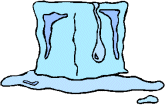

Temperature
 The hotness or coldness of a substance is called its temperature. At the microscopic level, temperature is a measurement of the kinetic energy, or average speed of motion, of a molecule. Air temperature changes with height. Since the number of air molecules decreases with height, it is sometimes assumed that temperature also decreases with height. This, however, is not always the case. Each layer in the atmosphere has its own temperature profile. In the troposphere and mesosphere, air temperature usually decreases with increasing altitude, whilst in the stratosphere, air temperature rises with increasing altitude. In the outer atmosphere or thermosphere, air temperature can rise to over 1000°C. However because the air is so thin, such values are not comparable to those in the lower atmosphere, where the air is much denser. Although the measured temperature in the thermosphere is very hot, the thermosphere would actually feel very cold to us because the total energy of only a few air molecules residing there would not be enough to transfer any appreciable heat to our skin.
The hotness or coldness of a substance is called its temperature. At the microscopic level, temperature is a measurement of the kinetic energy, or average speed of motion, of a molecule. Air temperature changes with height. Since the number of air molecules decreases with height, it is sometimes assumed that temperature also decreases with height. This, however, is not always the case. Each layer in the atmosphere has its own temperature profile. In the troposphere and mesosphere, air temperature usually decreases with increasing altitude, whilst in the stratosphere, air temperature rises with increasing altitude. In the outer atmosphere or thermosphere, air temperature can rise to over 1000°C. However because the air is so thin, such values are not comparable to those in the lower atmosphere, where the air is much denser. Although the measured temperature in the thermosphere is very hot, the thermosphere would actually feel very cold to us because the total energy of only a few air molecules residing there would not be enough to transfer any appreciable heat to our skin.
 Most temperature scales today are expressed in degrees Celsius (°C), although in the United States, the Fahrenheit (°F) is still in use. The Celsius scale is fixed by two points, the freezing and boiling point of water, which at normal atmospheric pressure are 0°C and 100°C respectively. The scale is then divided into 100 units. 0°C is equivalent to 32°F and 100°C to 212°F. The Kelvin temperature scale is the absolute temperature scale. Absolute zero, the coldest temperature possible in the universe, is 0K or -273°C. One Kelvin is equivalent to one degree Celsius, so 0°C is the same as 273K, and 15°C is the same as 288K.
Most temperature scales today are expressed in degrees Celsius (°C), although in the United States, the Fahrenheit (°F) is still in use. The Celsius scale is fixed by two points, the freezing and boiling point of water, which at normal atmospheric pressure are 0°C and 100°C respectively. The scale is then divided into 100 units. 0°C is equivalent to 32°F and 100°C to 212°F. The Kelvin temperature scale is the absolute temperature scale. Absolute zero, the coldest temperature possible in the universe, is 0K or -273°C. One Kelvin is equivalent to one degree Celsius, so 0°C is the same as 273K, and 15°C is the same as 288K.
In the case of two substances or bodies at different temperatures, heat will flow from the hotter to the colder until their temperatures are identical and thermal equilibrium is reached. When heat flows from a hotter object to a colder one, the temperature of the former decreases whilst the temperature of the latter increases. When thermal equilibrium is reached, the temperature of the two objects will be the same. There are three main mechanisms for transferring heat in this way: conduction, convection and radiation. In conduction, heat or thermal energy is transferred by the collisions that take place between heat-carrying molecules. Convection, by contrast, involves the bodily movement of the more energetic molecules in a liquid or gas, for example air. Transfer of energy by radiation involves the flow of electromagnetic radiation. Unlike conduction and convection, radiation can take place across a vacuum, like space.
Radiation is the principal means by which the Earth receives energy from the Sun (in the form of light and ultraviolet radiation). The Earth, too, emits radiation, but because its temperature is much lower than that of the Sun, it is much weaker in intensity (in the form of infrared radiation). The Earth has a flowing atmosphere, however, and consequently much of its heat is redistributed around the world by convection. Indeed convection is the major process of energy transfer in the atmosphere which causes weather phenomena. Since the temperature of the Earth's surface is usually higher nearer the equator than nearer the poles, heat is transferred by the generation of pressure differences and the accompanying development of global wind patterns. Without this global transfer of heat, the equator would be 14°C warmer on average than now, whilst the North Pole would be 25°C colder.
 | Atmospheric temperature |
Websites
Other topics
• About Temperature
• EXPLORES!
• Temperature Scales
• Temperature World
• Introduction
• Aerosols
• Air
• Air Gases
• Air Layers
• Aurora
• Blue Sky
• Clouds
• Coriolis Force
• Cosmic Rays
• Energy
• Exosphere
• Ionosphere
• Jet Stream
• Magnetosphere
• Mesosphere
• Meteors
• Moisture
• Nitrogen
• Oxygen
• Ozone Hole
• Ozone Layer
• Pollution
• Pressure
• Stratosphere
• Temperature
• Thermosphere
• Trace Gases
• Troposphere
• Weather
• Wind
 Print Topic
Print Topic